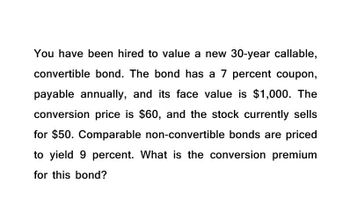
FINANCIAL ACCOUNTING
10th Edition
ISBN: 9781259964947
Author: Libby
Publisher: MCG
expand_more
expand_more
format_list_bulleted
Question

Transcribed Image Text:You have been hired to value a new 30-year callable,
convertible bond. The bond has a 7 percent coupon,
payable annually, and its face value is $1,000. The
conversion price is $60, and the stock currently sells
for $50. Comparable non-convertible bonds are priced
to yield 9 percent. What is the conversion premium
for this bond?
Expert Solution
This question has been solved!
Explore an expertly crafted, step-by-step solution for a thorough understanding of key concepts.
Step by stepSolved in 2 steps

Knowledge Booster
Similar questions
- Please help mearrow_forwardGive true answerarrow_forwardThe market price of a 10-year bond is 957$, its yield to maturity is 8% per year, and annual coupon payments are equal to 957$. The face value of the bond is $1000. Calculate the present value of the bond. Would you buy it? The answer is to be written in the reasons box. Round your answer to the nearest tenth. Optional: Provide calculation details in the reasons box. Answer: Give your reasonsarrow_forward
- Your client is considering the purchase of a bond that is currently selling for $1058.15. The client wants to know what annual rate of return can they expect to earn on the bond. The bond has 27 years to maturity, pays a coupon rate of 7.8% (payments made semi-annually), and a face value of $1000, (Round to 100th of a percent and enter your answer as a percentage, e.g. 12.34 for 12.34%) Answer: Checkarrow_forwardYou purchase a bond with an invoice price of $1,041. The bond has a coupon rate of 5.63 percent, it makes semiannual payments, and there are 5 months to the next coupon payment. The par value is $1,000. What is the clean price of the bond?arrow_forwardConsider a(n) Ten-year, 14.5 percent annual coupon bond with a face value of $1,000. The bond is trading at a rate of 11.5 percent. a. What is the price of the bond?b. If the rate of interest increases 1 percent, what will be the bond’s new price?c. Using your answers to parts (a) and (b), what is the percentage change in the bond’s price as a result of the 1 percent increase in interest rates? (Negative value should be indicated by a minus sign.)d. Repeat parts (b) and (c) assuming a 1 percent decrease in interest rates. (For all requirements, do not round intermediate calculations. Round your answers to 2 decimal places. (e.g., 32.16)) a. Price of the bond b. Bond's new price c. Percentage change % d. Bond's new price Percentage change %arrow_forward
- You purchase a bond with a par value of $1,000 and an invoice price of $1,044. The bond has a coupon rate of 5.1 percent, and there are 4 months to the next semiannual coupon date. What is the clean price of the bond? (Do not round intermediate calculations and round your answer to 2 decimal places, e.g., 32.16.) Clean price _arrow_forwardYou are considering the purchase of a Zero Coupon Bond. This bond has a coupon rate of 0%, a face value of $1000 and a 17-year maturity. The seller is offering the bonds at a price of $830. What is the YTM the seller is offering on the bonds? Assume annual compounding.arrow_forwardYou have just been offered a $1,000 par value bond for $847.88. The coupon rate is 8 percent, payable annually, and yields to maturity on new issues of similar risk are 10 percent. You want to know how many more interest payments you will receive, but the party selling the bond cannot remember. Can you determine how many interest payments remain?arrow_forward
- You are considering the purchase of a $1,000 par value bond with a coupon rate of 5.7% (with interest paid semiannually) that matures in 12 years. If the bond is priced to yield 8%, what is the bond's current price? The bond's current price is $ (Round to the nearest cent.) 0 www.arrow_forwardA convertible bond has a coupon of 9 percent, paid semiannually, and will mature in 12 years. If the bond were not convertible, it would be priced to yield 8 percent. The conversion ratio on the bond is 25 and the stock is currently selling for $43 per share. What is the minimum value of this bond? (Do not round intermediate calculations. Round your answer to 2 decimal places.) Minimum valuearrow_forwardYour broker offers to sell you a CleenWtr Bond for $1150. The bond has a coupon rate of 3%, semiannual interest payments, and a maturity of 9 years. If the interest rate on comparable debt is 2.0% is your broker fairly pricing the bond? (What is the curent price of the bond)arrow_forward
arrow_back_ios
SEE MORE QUESTIONS
arrow_forward_ios
Recommended textbooks for you

 AccountingAccountingISBN:9781337272094Author:WARREN, Carl S., Reeve, James M., Duchac, Jonathan E.Publisher:Cengage Learning,
AccountingAccountingISBN:9781337272094Author:WARREN, Carl S., Reeve, James M., Duchac, Jonathan E.Publisher:Cengage Learning, Accounting Information SystemsAccountingISBN:9781337619202Author:Hall, James A.Publisher:Cengage Learning,
Accounting Information SystemsAccountingISBN:9781337619202Author:Hall, James A.Publisher:Cengage Learning, Horngren's Cost Accounting: A Managerial Emphasis...AccountingISBN:9780134475585Author:Srikant M. Datar, Madhav V. RajanPublisher:PEARSON
Horngren's Cost Accounting: A Managerial Emphasis...AccountingISBN:9780134475585Author:Srikant M. Datar, Madhav V. RajanPublisher:PEARSON Intermediate AccountingAccountingISBN:9781259722660Author:J. David Spiceland, Mark W. Nelson, Wayne M ThomasPublisher:McGraw-Hill Education
Intermediate AccountingAccountingISBN:9781259722660Author:J. David Spiceland, Mark W. Nelson, Wayne M ThomasPublisher:McGraw-Hill Education Financial and Managerial AccountingAccountingISBN:9781259726705Author:John J Wild, Ken W. Shaw, Barbara Chiappetta Fundamental Accounting PrinciplesPublisher:McGraw-Hill Education
Financial and Managerial AccountingAccountingISBN:9781259726705Author:John J Wild, Ken W. Shaw, Barbara Chiappetta Fundamental Accounting PrinciplesPublisher:McGraw-Hill Education


Accounting
Accounting
ISBN:9781337272094
Author:WARREN, Carl S., Reeve, James M., Duchac, Jonathan E.
Publisher:Cengage Learning,

Accounting Information Systems
Accounting
ISBN:9781337619202
Author:Hall, James A.
Publisher:Cengage Learning,

Horngren's Cost Accounting: A Managerial Emphasis...
Accounting
ISBN:9780134475585
Author:Srikant M. Datar, Madhav V. Rajan
Publisher:PEARSON

Intermediate Accounting
Accounting
ISBN:9781259722660
Author:J. David Spiceland, Mark W. Nelson, Wayne M Thomas
Publisher:McGraw-Hill Education

Financial and Managerial Accounting
Accounting
ISBN:9781259726705
Author:John J Wild, Ken W. Shaw, Barbara Chiappetta Fundamental Accounting Principles
Publisher:McGraw-Hill Education